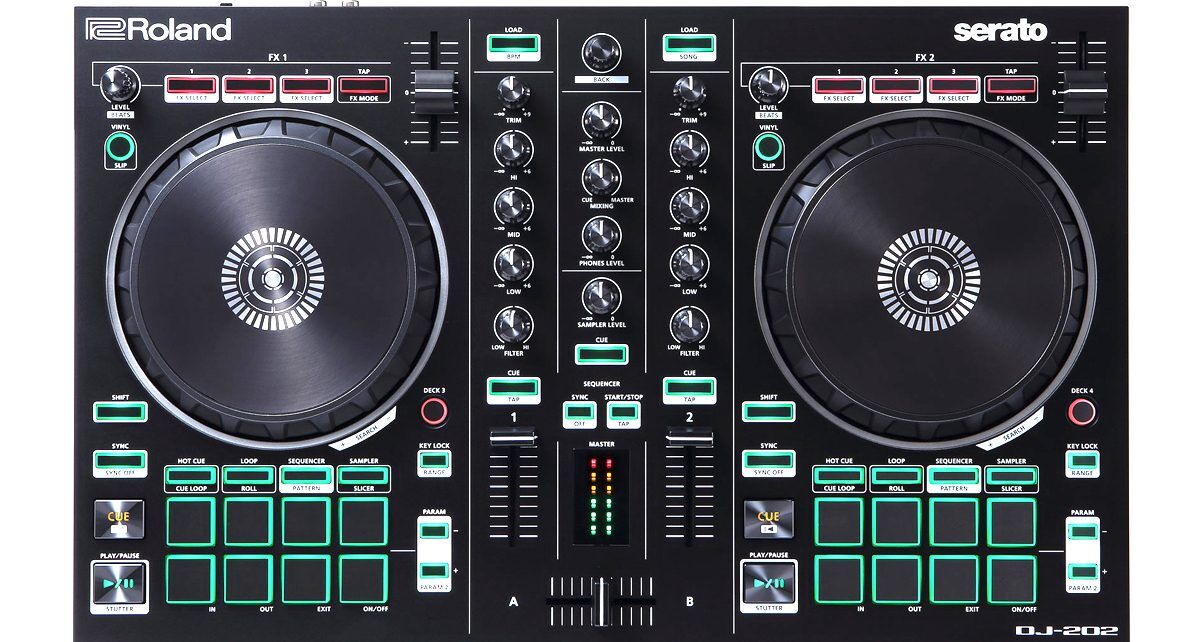The Lowdown
The Roland DJ-202 is a two-channel, four-deck controller for Serato DJ Pro with two large jogwheels, a three-band EQ section with filter and gain knobs, transport controls, mic input with Roland’s Vocal FX, and eight performance pads per channel. It also comes with a built-in drum machine containing samples from Roland’s legendary TR-606, TR-707, TR-808 and TR-909 drum kits, which can be sequenced and triggered via the performance pads. A good entry-level deck for DJ/producers who want to specialise in house or techno with an emphasis in layering loops and samples during performances. It can get a bit complicated though because much of the controls used for the sequencer perform double (sometimes triple) duty.
Video Review
First Impressions / Setting up
The Roland DJ-202 is the entry-level model in the company’s line of Serato DJ Pro controllers that also included the DJ-505 and the flagship DJ-808. The DJ-202 looks very similar to Pioneer DJ’s DDJ-SB2 device: you’ve got two jogwheels on either side of the unit that have a full complement of performance pads, transport controls and an FX section. It has a two-channel mixer with trim pots, three-band EQs and filter knobs per channel. Roland adds in a few unique features into the mix though: there’s a mic input that’s got vocal FX, plus a built-in sampler and pattern sequencer that’s got sounds from Roland’s legendary drum kits (more on these later).
The rear of the unit has a USB jack for connecting to your laptop, a Midi Out port for connecting to other Midi-enabled gear such as those found in Roland’s Aira line of synths and drum machines, RCA master output jacks, and a 1/4″ mic input with a level knob. The front of the unit has a 1/4″ jack for plugging in your headphones.
In Use
Build quality
The DJ-202 is about the same size as a Pioneer DJ DDJ-SB2. It’s quite light and feels a bit hollow – it’s made of plastic after all, so don’t expect anything heavy duty like the more expensive DJ-505 or DJ-808. That said, it doesn’t feel cheap: the jogwheels are weighted and have a nice fight to them, which will please DJs who prefer stiffer jogs. There are deck select buttons for controlling decks 3 and 4 in Serato DJ Pro, which is a nice addition. The pitch faders here are ultra-short throw, similar to the DDJ-SB2’s, and a bit flimsy and wobbly too. Thankfully, all the other controls feel solid, from the transport buttons down to the mixer knobs and crossfader / volume faders. My main issue is that the performance pads are a bit too stiff, making hot cue juggling and speedy finger drumming that much harder. It’s safe to assume that people who buy this will also want to trigger samples manually using the pads apart from just sequencing them, and having pads that require more force just to register a pad press might turn off beginners who want to get into pad drumming, as well as intermediate DJs who are coming from more responsive / sensitive pads.
Drum pattern sequencer
The Roland DJ-202 comes with sounds from four of Roland’s electronic drum kits: the TR-808, TR-707, TR-606 and TR-909. These are legendary drum sounds that have been used in countless dance, pop and hip-hop records and you still hear them a lot today. Those sounds are built-into the unit, and that’s both good and bad: good because you don’t need to install any extra software just to access the sounds, and you don’t need to mess with Serato DJ’s Sampler just to use them (though you still can use Serato’s Sampler via the Sampler performance pad function). It’s bad because that means you’re locked into using whatever controls are found on the DJ-202 to trigger, edit, save and playback those drum samples and patterns.
This is easier to do with the higher-end DJ-808 and DJ-505 because they’ve got dedicated controls for the Sequencer such as 16 buttons for each of the 16 steps in the Pattern Sequencer and knobs to modify the drum samples. The top shelf DJ-808 even has volume faders for the kick, snare, and hi-hats. While you can do the sample triggering and pattern sequencing on the DJ-202 just as you would on the DJ-505 and DJ-808 in theory, the overall experience isn’t as fluid or intuitive and can sometimes be frustrating, especially for new DJs.
For example, if you would want to add a four-to-the-floor kick drum pattern on the DJ-808, you would press the kick drum button on the dedicated TR-Sampler section at the top of the controller, press step buttons 1, 5, 9 and 13, hit “Start” and you’ve got your four kick drums playing in a loop. On the DJ-202, it’s less of a straightforward process. You press the Sequencer button then you hold Shift and press the Parameter 2 button: the eight pads now let you choose which drum sample you’d like to sequence. Pad 1 is a kick drum, Pad 2 is a snare, Pad 3 is a hi-hat and so on. Once you’ve picked the sound, you can then add or a remove a drum hit across the 16 steps using the performance pads again. Since there are only eight pads, you’ll have to press the Parameter 2 button to access steps 9-16. Wash, rinse and repeat for all the other drum sounds you’d want to add in your pattern.
Triggering the patterns, though, isn’t as tough: Hold Shift and press the Sequencer button to access the Pattern function for the performance pads, and you can trigger the patterns using them. The patterns launch in a quantised fashion, which is especially useful if you’re triggering patterns alongside a track that you’ve currently got playing in your Serato DJ decks – the Sequencer comes with a sync button that ties it to the master tempo in Serato DJ.
So yes, creating sequences on the DJ-202 isn’t as intuitive as it is on the DJ-505 and DJ-808, but it’s still doable especially if you’re only making simple drum patterns to begin with.
Vocal FX
The DJ-202 comes with some vocal FX built in: reverb, delay, a noise gate as well as a low cut filter for for reducing handling noise like bumps and thuds. You’ll have to enter a “System Settings” mode to do this though, which involves pressing the Load button and unplugging / plugging your DJ-202, and then your only visual feedback would be the master LED meters on the unit. It’s not as user-friendly as clicking a dropdown with your mouse but if you really need to do it, it’s possible – don’t just do it in the middle of your set because you’re basically restarting your controller!
Conclusion
The DJ-202 is a decent offering from Roland, though it does feel that its more advanced features feel a bit shoehorned into the unit: the Pattern Sequencer were elegant live performance solutions for DJ/producers on the DJ-808 and DJ-505. On the DJ-202, it feels a bit clunky, though passable for more basic pattern sequencing. The vocal FX could also have been implemented better, and as it stands they are nowhere near the versatility and usability of the vocal FX found on the DJ-808 which includes, among other things, auto tune.
The good news is that the DJ-202 gets all of the DJ controller basics right: the jogwheels have a great feel to them and are responsive (you can even adjust the sensitivity of the platters in the aforementioned System Settings menu), the knobs and buttons feel solid, and you have an assortment of performance pad functions that will get you through just about any gig that you’re likely to encounter. The pads themselves could be more sensitive and responsive, but at least it feels like they’re going to last for a very long time.
If you’re in the market for a DJ controller that has some sequencing functions but you’re on a budget, the DJ-202 should be on your list though you may want to save up a bit more to get at least the DJ-505 which makes sequencing a more intuitive affair. Overall, a decent entry-level offering from Roland.


